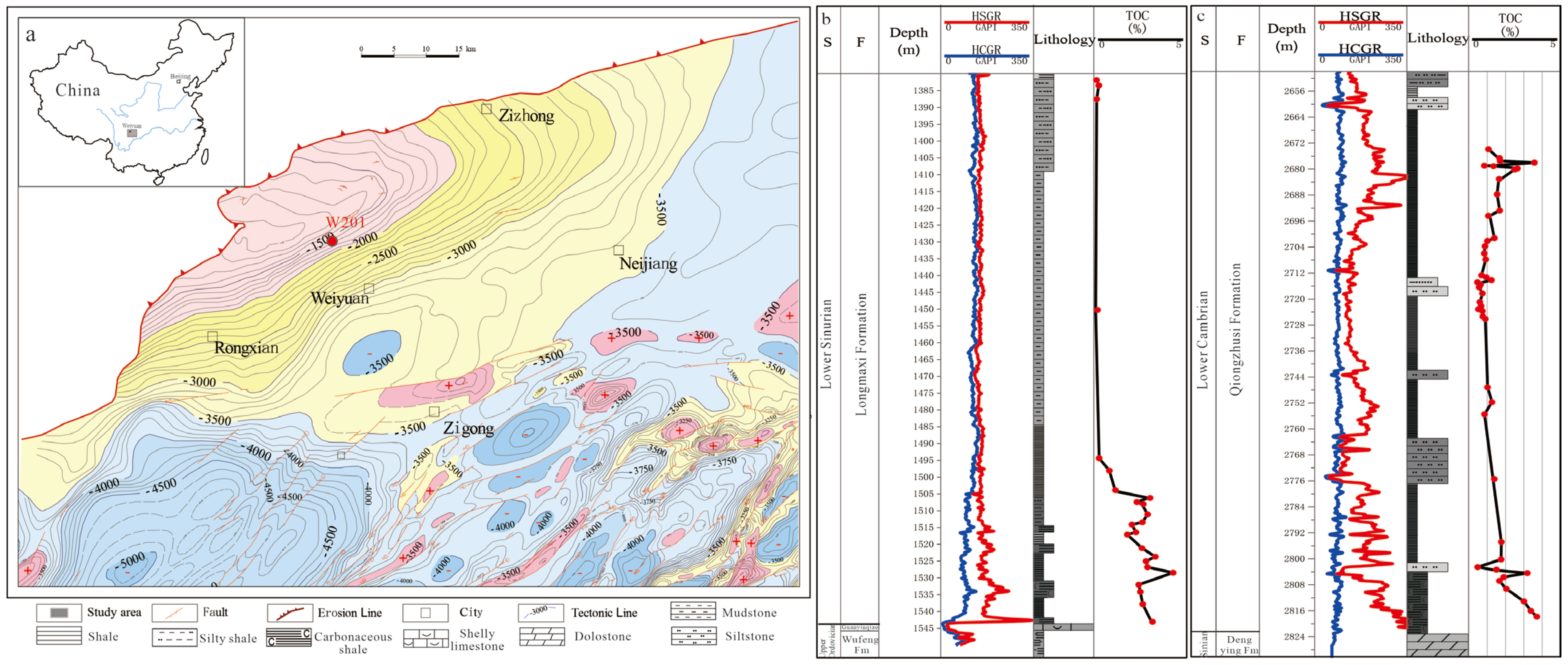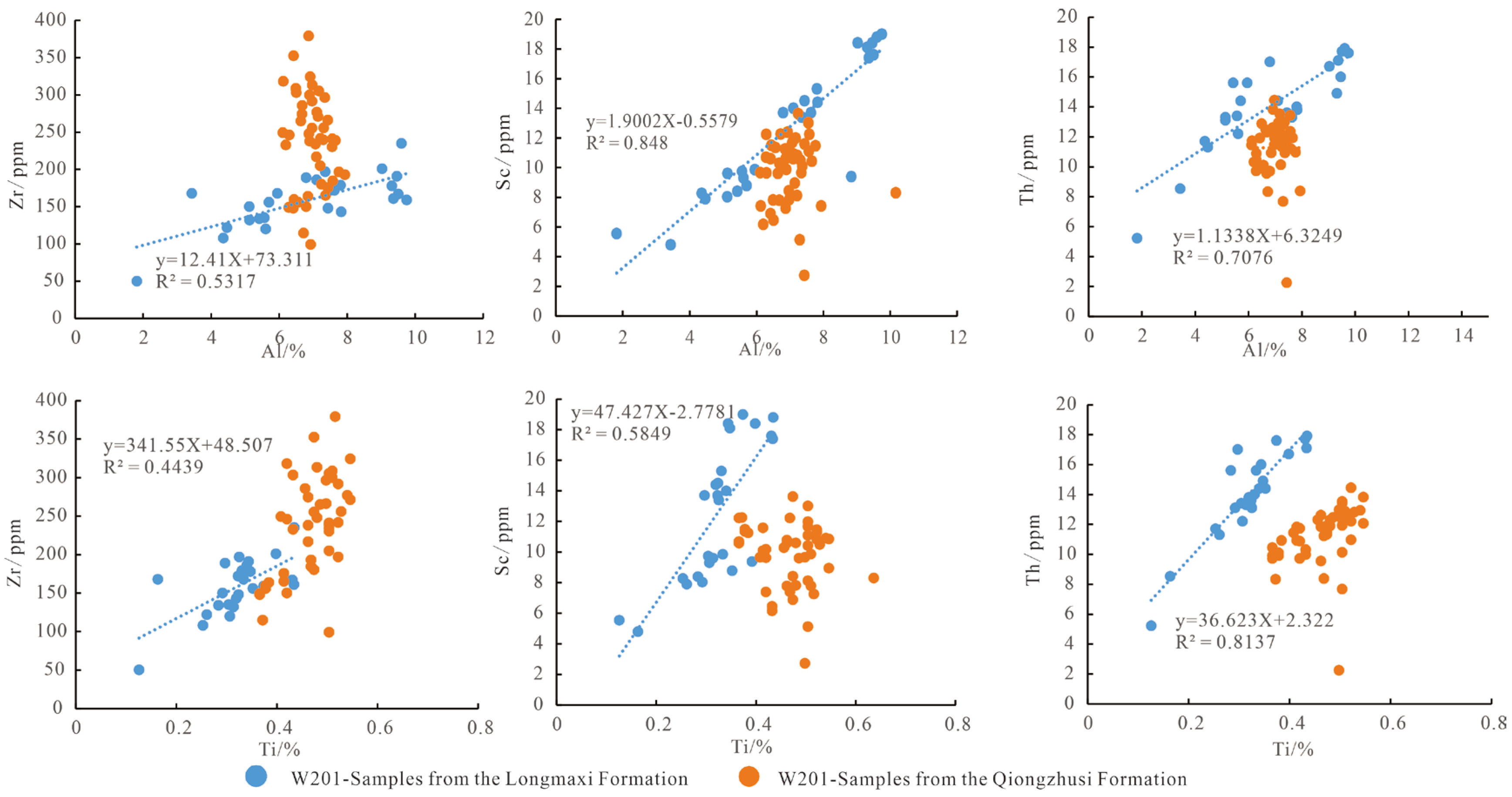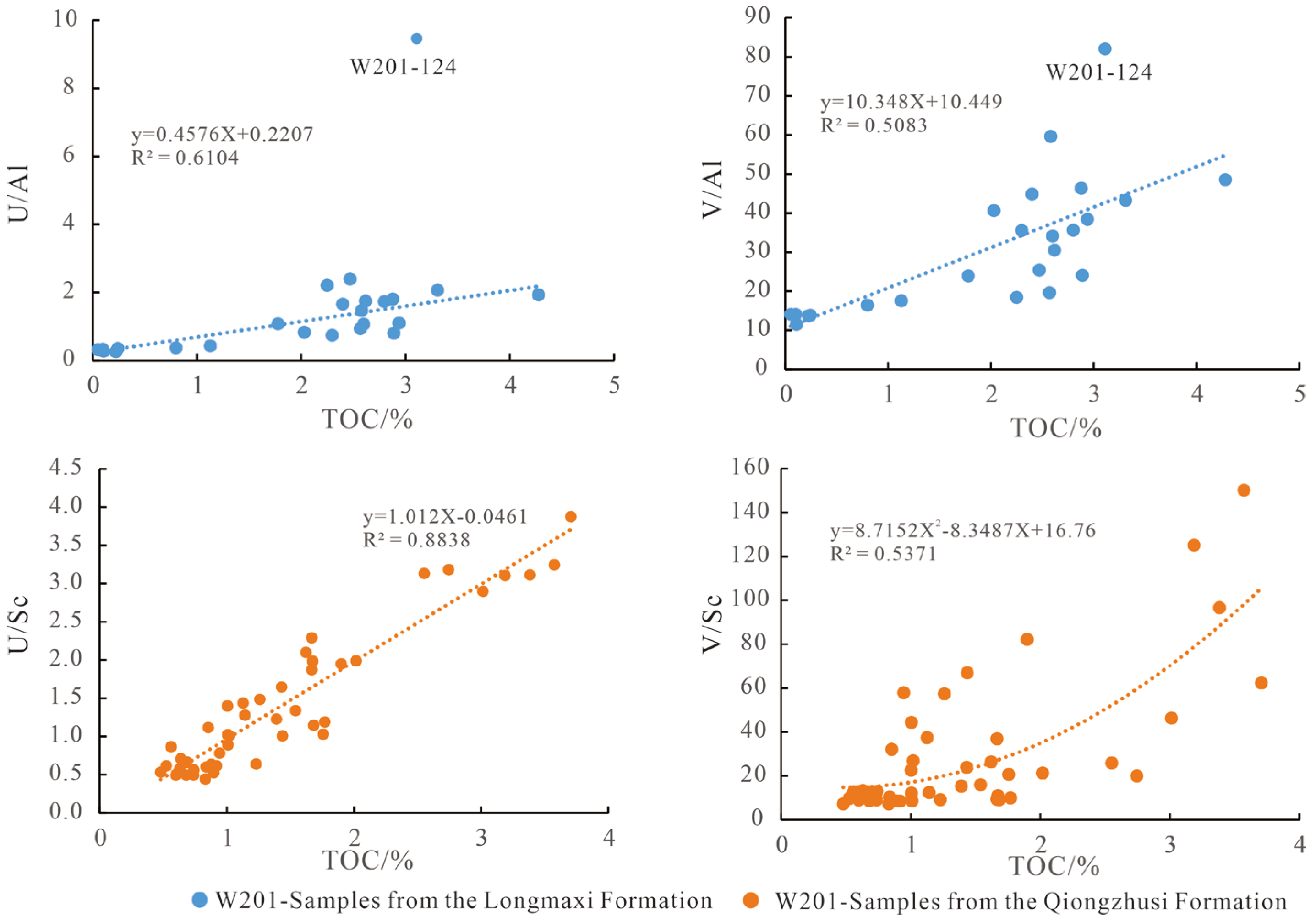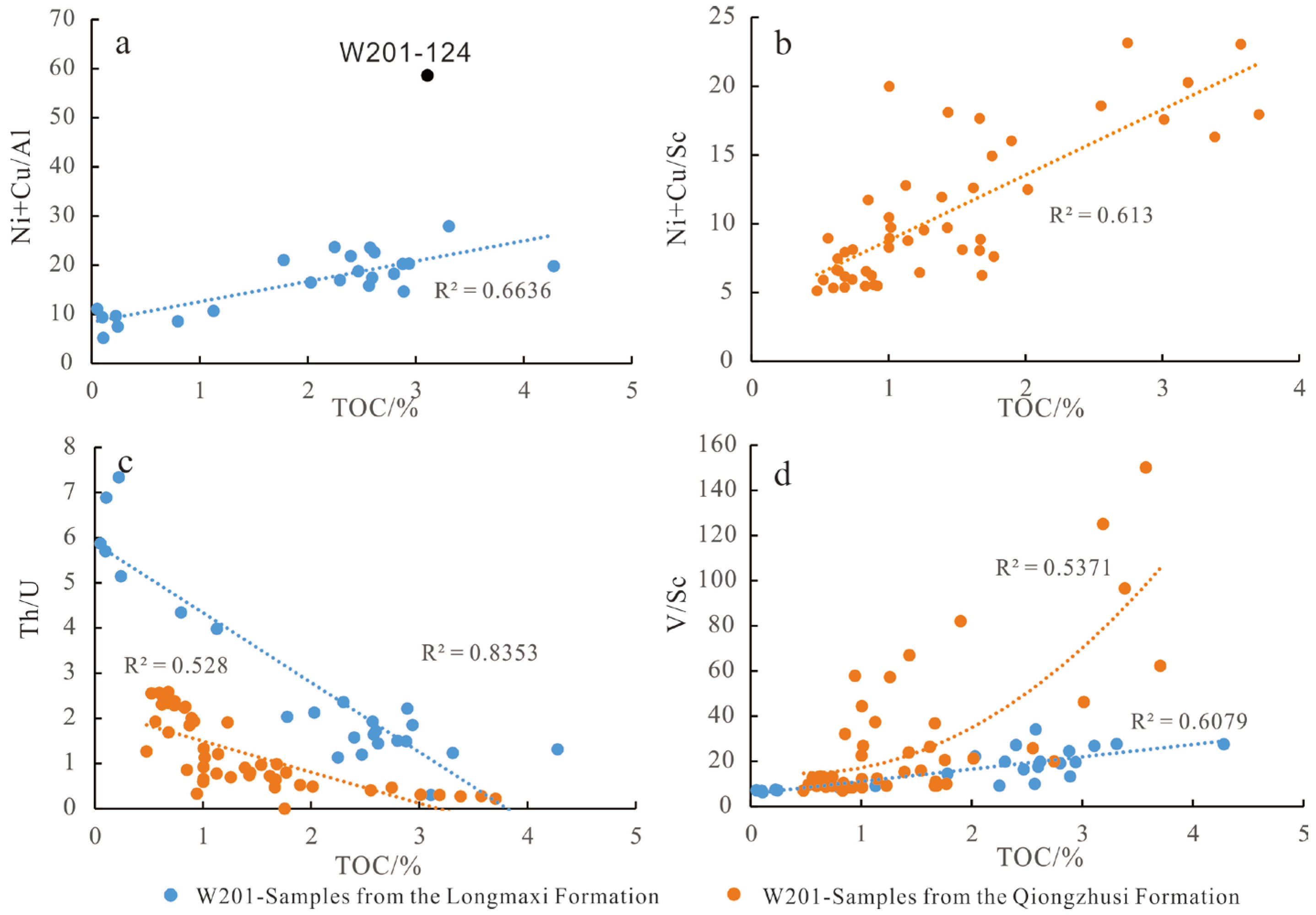Paleoenvironment Comparison of the Longmaxi and Qiongzhusi Formations, Weiyuan Shale Gas Field, Sichuan Basin
Abstract
1. Introduction
2. Geological Background
3. Materials and Methods
3.1. Experimental Methods
3.2. Data Presentation
4. Results
4.1. TOC and Mineral Composition
4.2. Major Elements
4.3. Trace Elements
4.4. Rare Earth Elements (REEs)
5. Discussion
5.1. Redox Proxies
5.2. Paleoclimate
5.3. Paleoproductivity
5.4. Hydrothermal Depositional Condition
5.5. Organic Matter Enrichment Mechanism
6. Conclusions
- (1)
- Both the Longmaxi and Qiongzhusi formations were deposited in non-sulfidic seawater, and the paleoclimate was warm and humid.
- (2)
- The redox conditions of the Longmaxi formation varied from reducing to oxidizing from bottom to top, while the redox conditions of the Qiongzhusi formation experienced three stages, from anoxic to oxic to suboxic. The anoxic conditions in the Qiongzhusi formation are considerably stronger than those in the Longmaxi formation.
- (3)
- The Longmaxi formation was primarily controlled by seawater, whereas the Qiongzhusi formation was jointly influenced by seawater and hydrothermal fluid. Paleoproductivity and the covariation of redox conditions jointly controlled organic matter enrichment for the Longmaxi and Qiongzhusi formations.
- (4)
- Due to the low detrital input and high TOC content, the bottom sections of the Longmaxi and the Qiongzhusi formations are favorable sections for shale gas exploration.
Supplementary Materials
Author Contributions
Funding
Acknowledgments
Conflicts of Interest
References
- Shen, B.; Tao, Y.; Wang, G.; Fan, H.; Wang, X.; Sun, K. A New Method for Mobility Logging Evaluation Based on Flowing Porosity in Shale Oil Reservoirs. Processes 2023, 11, 1466. [Google Scholar] [CrossRef]
- Zhang, T.; Bai, H.; Sun, S. Intelligent Natural Gas and Hydrogen Pipeline Dispatching Using the Coupled Thermodynamics-Informed Neural Network and Compressor Boolean Neural Network. Processes 2022, 10, 428. [Google Scholar] [CrossRef]
- Xu, J.; Wu, K.; Li, R.; Li, Z.; Li, J.; Xu, Q.; Li, L.; Chen, Z. Nanoscale pore size distribution effects on gas production from fractal shale rocks. Fractals 2019, 27, 1950142. [Google Scholar] [CrossRef]
- Xu, J.; Wu, K.; Li, R.; Li, Z.; Li, J.; Xu, Q.; Chen, Z. Real gas transport in shale matrix with fractal structures. Fuel 2018, 219, 353–363. [Google Scholar] [CrossRef]
- Kokkinos, N.C.; Nkagbu, D.C.; Marmanis, D.I.; Dermentzis, K.I.; Maliaris, G. Evolution of Unconventional Hydrocarbons: Past, Present, Future and Environmental FootPrint. J. Eng. Sci. Technol. Rev. 2022, 15, 15–24. [Google Scholar] [CrossRef]
- Zou, C.N.; Dong, D.Z.; Wang, S.J. Geological characteristics, formation mechanism and resource potential of shale gas in China. Pet. Explor. Dev. 2010, 37, 641–653. [Google Scholar] [CrossRef]
- Li, Y.X.; Zhang, D.W.; Zhang, J.C. Criteria for and significance of government’s approving shale gas as a newly found mineral. Nat. Gas Ind. 2012, 32, 93–98. [Google Scholar]
- Ma, X.; Li, X.; Liang, F.; Wan, Y.; Shi, Q.; Wang, Y.; Zhang, X.; Che, M.; Guo, W. Dominating factors on well productivity and development strategies optimization in Weiyuan shale gas play, Sichuan Basin, SW China. Pet. Explor. Dev. 2020, 47, 594–602. [Google Scholar] [CrossRef]
- Zhou, W.; Xu, H.; Yu, Q. Shale gas-bearing property differences and their genesis between Wufeng-Longmaxi Formation and Qiongzhusi Formation in Sichuan Basin and surrounding areas. Lithol. Reserv. 2016, 28, 18–25. [Google Scholar]
- Xu, C.; Yao, S.; Song, D. Types, chemical and porosity characteristics of hydrocarbon-generating organisms of the lower Paleozoic, south China—Taking Longmaxi Formation and Qiongzhusi Formation in Sichuan Basin as examples. Mar. Pet. Geol. 2020, 119, 104508. [Google Scholar] [CrossRef]
- Jiao, K.; Ye, Y.; Liu, S.; Ran, B.; Deng, B.; Li, Z.; Li, J.; Yong, Z.; Sun, W. Characterization and Evolution of Nanoporosity in Superdeeply Buried Shales: A Case Study of the Longmaxi and Qiongzhusi Shales from MS Well #1, North Sichuan Basin, China. Energy Fuels 2017, 32, 191–203. [Google Scholar] [CrossRef]
- Zhao, P.; Li, X.Q.; Sun, J. Study on mineral composition and brittleness characteristics of shale gas reservoirs from the Lower Paleozoic in the Southern Sichuan Basin. Geoscience 2014, 28, 396–403. [Google Scholar]
- Zhu, Y.M.; Zhang, H.; Kang, W. Organic nanopores of Longmaxi and Qiongzhusi Formations in the Upper Yangtze: Biological precursor and pore network. Nat. Gas Geosci. 2015, 26, 1507–1515. [Google Scholar]
- Li, A.; Ding, W.L.; Zhang, G.L. Reservoir characteristics of marine shale in the Malong block of Eastern Yunnan Province and comparison analysis. Earth Sci. Front. 2016, 23, 176–189. [Google Scholar]
- Liang, X.; Zhang, T.S.; Yang, Y. Microscopic pore structure and its controlling factors of overmature shale in the Lower Cambrian Qiongzhusi Fm. North. Yunnan Guizhou Prov. China. Nat. Gas Ind. 2014, 34, 18–26. [Google Scholar]
- Li, T.; Tian, H.; Xiao, X.; Cheng, P.; Zhou, Q.; Wei, Q. Geochemical characterization and methane adsorption capacity of overmature organic-rich Lower Cambrian shales in northeast Guizhou region, southwest China. Mar. Pet. Geol. 2017, 86, 858–873. [Google Scholar] [CrossRef]
- Wu, C.; Tuo, J.; Zhang, M.; Sun, L.; Qian, Y.; Liu, Y. Sedimentary and residual gas geochemical characteristics of the Lower Cambrian organic-rich shales in Southeastern Chongqing, China. Mar. Pet. Geol. 2016, 75, 140–150. [Google Scholar] [CrossRef]
- Milliken, K.L.; Olson, T. Silica Diagenesis, Porosity Evolution, and Mechanical Behavior in Siliceous Mudstones, Mowry Shale (Cretaceous), Rocky Mountains, U.S.A. J. Sediment. Res. 2017, 87, 366–387. [Google Scholar] [CrossRef]
- Tang, J.; Li, J.; Tang, M.; Du, X.; Yin, J.; Guo, X.; Wu, K.; Xiao, L. Investigation of multiple hydraulic fractures evolution and well performance in lacustrine shale oil reservoirs considering stress heterogeneity. Eng. Fract. Mech. 2019, 218, 106569. [Google Scholar] [CrossRef]
- Li, Y.F.; Lv, H.G.; Zhang, Y. U-Mo covariation in marine shales of Wufeng-Longmaxi Formations in Sichuan Basin, China and its implication for identification of watermass restriction. GeoChimica 2015, 44, 109–111. [Google Scholar]
- Li, Y.; Zhang, T.; Ellis, G.S.; Shao, D. Depositional environment and organic matter accumulation of Upper Ordovician–Lower Silurian marine shale in the Upper Yangtze Platform, South China. Palaeogeogr. Palaeoclim. Palaeoecol. 2017, 466, 252–264. [Google Scholar] [CrossRef]
- Zhang, C.M.; Zhang, W.S.; Guo, Y.H. Sedimentary environment and its effect on hydrocarbon source rocks of Longmaxi Formation in southeast Sichuan and northern Guizhou. Earth Sci. Front. 2012, 32, 124–130. [Google Scholar]
- Wang, Y.M.; Li, X.J.; Dong, D.Z. Main factors controlling the sedimentation of high-quality shale in Wufeng-Longmaxi Fm, Upper Yangtze region. Nat. Gas Ind. 2017, 37, 9–20. [Google Scholar] [CrossRef]
- He, L. Organic Matter Enrichment and Evolution of Sedimentary Environment of the Wufeng-Longmaxi Shale Southeastern Margins of the Sichuan Basin. Ph.D. Thesis, University of Chinese Academy of Sciences, Guangzhou Institute of Geochemistry, Chinese Academy of Sciences, Guangzhou, China, 2020. [Google Scholar]
- Zhao, J.H.; Jin, Z.J.; Jin, Z.K. Depositional environment of shale in Wufeng and Longmaxi Formations, Sichuan Basin. Pet. Res. 2017, 2, 209–221. [Google Scholar] [CrossRef]
- Yan, C.; Jin, Z.; Zhao, J.; Du, W.; Liu, Q. Influence of sedimentary environment on organic matter enrichment in shale: A case study of the Wufeng and Longmaxi Formations of the Sichuan Basin, China. Mar. Pet. Geol. 2018, 92, 880–894. [Google Scholar] [CrossRef]
- Shi, Z.; Qiu, Z.; Dong, D.; Lu, B.; Liang, P.; Zhang, M. Lamina characteristics of gas-bearing shale fine-grained sediment of the Silurian Longmaxi Formation of Well Wuxi 2 in Sichuan Basin, SW China. Pet. Explor. Dev. 2018, 45, 358–368. [Google Scholar] [CrossRef]
- Zhao, J.H.; Jin, Z.K.; Jin, Z.J. Applying sedimentary geochemical proxies for paleoenvironment interpretation of organic-rich shale deposition in the Sichuan Basin, China. Int. J. Coal Geol. 2016, 163, 52–71. [Google Scholar] [CrossRef]
- Lu, L.F.; Qin, J.Z.; Shen, B.J. Biogenic origin and hydrocarbon significance of siliceous shale from the Wufeng-Longmaxi Formations in Fuling area, southeastern Sichuan Basin. Pet. Geol. Exp. 2016, 38, 460–465+472. [Google Scholar]
- Zhao, J.H.; Jin, Z.K.; Jin, Z.J. Origin of authigenic quartz in organic-rich shales of the Wufeng and Longmaxi Formations in the Sichuan Basin, South China: Implications for pore evolution. J. Nat. Gas Sci. Eng. 2017, 38, 21–38. [Google Scholar] [CrossRef]
- Guo, Q.; Deng, Y.; Hippler, D.; Franz, G.; Zhang, J. REE and trace element patterns from organic-rich rocks of the Ediacaran–Cambrian transitional interval. Gondwana Res. 2016, 36, 94–106. [Google Scholar] [CrossRef]
- Chen, D.; Wang, J.; Qing, H.; Yan, D.; Li, R. Hydrothermal venting activities in the Early Cambrian, South China: Petrological, geochronological and stable isotopic constraints. Chem. Geol. 2009, 258, 168–181. [Google Scholar] [CrossRef]
- Goldberg, T.; Strauss, H.; Guo, Q.; Liu, C. Reconstructing marine redox conditions for the Early Cambrian Yangtze Platform: Evidence from biogenic sulphur and organic carbon isotopes. Palaeogeogr. Palaeoclim. Palaeoecol. 2007, 254, 175–193. [Google Scholar] [CrossRef]
- Guo, Q.; Strauss, H.; Liu, C.; Zhao, Y.; Yang, X.; Peng, J.; Yang, H. A negative carbon isotope excursion defines the boundary from Cambrian Series 2 to Cambrian Series 3 on the Yangtze Platform, South China. Palaeogeogr. Palaeoclim. Palaeoecol. 2010, 285, 143–151. [Google Scholar] [CrossRef]
- Pi, D.-H.; Liu, C.-Q.; Shields-Zhou, G.A.; Jiang, S.-Y. Trace and rare earth element geochemistry of black shale and kerogen in the early Cambrian Niutitang Formation in Guizhou province, South China: Constraints for redox environments and origin of metal enrichments. Precambrian Res. 2013, 225, 218–229. [Google Scholar] [CrossRef]
- Xia, P.; Fu, Y.; Yang, Z. The relationship between sedimentary environment and organic matter accumulation in the Niutitang black shale in Zhenyuan, northern Guizhou. Acta Geol. Sin. 2020, 94, 947–956. [Google Scholar]
- Huang, F.X.; Chen, H.D.; Hou, M.C. Filling process and evolutionaru model of sedimentary sequence of Midddle-Upper Yangtze craton in Caledonian (Cambrian-Silurian). Acta Petrol. Sin. 2011, 27, 2299–2317. [Google Scholar]
- Wang, S.; Zou, C.; Dong, D.; Wang, Y.; Li, X.; Huang, J.; Guan, Q. Multiple controls on the paleoenvironment of the Early Cambrian marine black shales in the Sichuan Basin, SW China: Geochemical and organic carbon isotopic evidence. Mar. Pet. Geol. 2015, 66, 660–672. [Google Scholar] [CrossRef]
- Tribovillard, N.; Algeo, T.J.; Lyons, T.; Riboulleau, A. Trace metals as paleoredox and paleoproductivity proxies: An update. Chem. Geol. 2006, 232, 12–32. [Google Scholar] [CrossRef]
- Taylor, S.R.; Mclennan, S.M. The Continental Crust: Its Composition and Evolution; Blackwell Scientific Publications: Oxford, UK, 1985. [Google Scholar]
- McLennan, S.M. Rare earth elements in sedimentary rocks; influence of provenance and sedimentary processes. Rev. Mineral. Geochem. 1989, 21, 169–200. [Google Scholar]
- Kryc, K.; Murray, R.; Murray, D. Al-to-oxide and Ti-to-organic linkages in biogenic sediment: Relationships to paleo-export production and bulk Al/Ti. Earth Planet. Sci. Lett. 2003, 211, 125–141. [Google Scholar] [CrossRef]
- Nesbitt, H.W.; Young, G.M. Formation and Diagenesis of Weathering Profiles. J. Geol. 1989, 97, 129–147. [Google Scholar] [CrossRef]
- Young, G.M.; Nesbitt, H.W. Paleoclimatology and provenance of the glaciogenic Gowganda Formation (Paleoproterozoic), Ontario, Canada: A chemostratigraphic approach. Geol. Soc. Am. Bull. 1999, 111, 264–274. [Google Scholar] [CrossRef]
- Dulski, P. Interferences of oxide, hydroxide and chloride analyte species in the determination of rare earth elements in geological samples by inductively coupled plasma-mass spectrometry. Fresenius’ J. Anal. Chem. 1994, 350, 194–203. [Google Scholar] [CrossRef]
- Algeo, T.J.; Maynard, J. Trace-element behavior and redox facies in core shales of Upper Pennsylvanian Kansas-type cyclothems. Chem. Geol. 2004, 206, 289–318. [Google Scholar] [CrossRef]
- Kimura, H.; Watanabe, Y. Oceanic anoxia at the Precambrian-Cambrian boundary. Geology 2001, 29, 995–998. [Google Scholar] [CrossRef]
- Nesbitt, H.W.; Young, G.M. Early Proterozoic climates and plate motions inferred from major element chemistry of lutites. Nature 1982, 299, 715–717. [Google Scholar] [CrossRef]
- He, L.; Wang, Y.P.; Chen, D.F. Geochemical features of sedimentary environment and paleoclimate during Late Ordovician to Early Silurian in southern Sichuan Basin. Geochimica 2019, 48, 555–566. [Google Scholar]
- Wang, X.; Shi, X.; Jiang, G.; Tang, D. Organic carbon isotope gradient and ocean stratification across the late Ediacaran-Early Cambrian Yangtze Platform. Sci. China Earth Sci. 2013, 57, 919–929. [Google Scholar] [CrossRef]
- Rogov, M.; Ershova, V.; Vereshchagin, O.; Vasileva, K.; Mikhailova, K.; Krylov, A. Database of global glendonite and ikaite records throughout the Phanerozoic. Earth Syst. Sci. Data 2021, 13, 343–356. [Google Scholar] [CrossRef]
- Mort, H.; Jacquat, O.; Adatte, T. The Cenomanian/Turonian anoxic event at the Bonarelli Level in Italy and Spain: Enhanced productivity and/or better preservation? Cretac. Res. 2007, 28, 597–612. [Google Scholar] [CrossRef]
- Adachi, M.; Yamamoto, K.; Sugisaki, R. Hydrothermal chert and associated siliceous rocks from the northern Pacific their geological significance as indication od ocean ridge activity. Sediment. Geol. 1986, 47, 125–148. [Google Scholar] [CrossRef]
- Olivarez, A.M.; Owen, R.M. The europium anomaly of seawater: Implications for fluvial versus hydrothermal REE inputs to the oceans. Chem. Geol. 1991, 92, 317–328. [Google Scholar] [CrossRef]
- Owen, W.A.; Armstrong, H.A.; Floyd, J.D. Rare earth element geochemistry of upper ordovician cherts from the southern uplands of Scotland. J. Geol. Soc. 1999, 156, 191–204. [Google Scholar] [CrossRef]
- Cheng, Y.; Liu, W.; Wu, W.; Zhang, Y.; Tang, G.; Liu, C.; Nie, Q.; Wen, Y.; Lu, P.; Zhang, C. Geochemical characteristics of the lower Cambrian Qiongzhusi Formation in Huize area, east Yunnan: Implications for paleo-ocean environment and the origin of black rock series. Arab. J. Geosci. 2021, 14, 2081. [Google Scholar] [CrossRef]
- Yan, D.T.; Chen, D.Z.; Wang, Z.Z. Climatic and oceanic controlled deposition of Late Ordovician-Early Silurian black shales on the North Yangtze platform, South China. Mar. Pet. Geol. 2019, 110, 112–121. [Google Scholar]









Disclaimer/Publisher’s Note: The statements, opinions and data contained in all publications are solely those of the individual author(s) and contributor(s) and not of MDPI and/or the editor(s). MDPI and/or the editor(s) disclaim responsibility for any injury to people or property resulting from any ideas, methods, instructions or products referred to in the content. |
© 2023 by the authors. Licensee MDPI, Basel, Switzerland. This article is an open access article distributed under the terms and conditions of the Creative Commons Attribution (CC BY) license (https://creativecommons.org/licenses/by/4.0/).
Share and Cite
Zhang, Q.; Liang, F.; Zeng, J.; Qiu, Z.; Zhou, S.; Liu, W.; Kong, W. Paleoenvironment Comparison of the Longmaxi and Qiongzhusi Formations, Weiyuan Shale Gas Field, Sichuan Basin. Processes 2023, 11, 2153. https://doi.org/10.3390/pr11072153
Zhang Q, Liang F, Zeng J, Qiu Z, Zhou S, Liu W, Kong W. Paleoenvironment Comparison of the Longmaxi and Qiongzhusi Formations, Weiyuan Shale Gas Field, Sichuan Basin. Processes. 2023; 11(7):2153. https://doi.org/10.3390/pr11072153
Chicago/Turabian StyleZhang, Qin, Feng Liang, Jingbo Zeng, Zhen Qiu, Shangwen Zhou, Wen Liu, and Weiliang Kong. 2023. "Paleoenvironment Comparison of the Longmaxi and Qiongzhusi Formations, Weiyuan Shale Gas Field, Sichuan Basin" Processes 11, no. 7: 2153. https://doi.org/10.3390/pr11072153
APA StyleZhang, Q., Liang, F., Zeng, J., Qiu, Z., Zhou, S., Liu, W., & Kong, W. (2023). Paleoenvironment Comparison of the Longmaxi and Qiongzhusi Formations, Weiyuan Shale Gas Field, Sichuan Basin. Processes, 11(7), 2153. https://doi.org/10.3390/pr11072153





